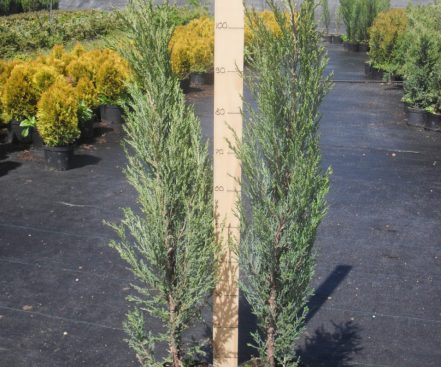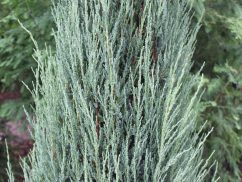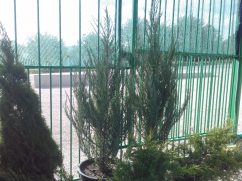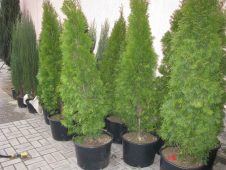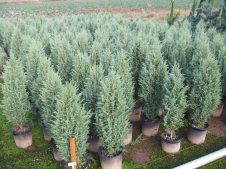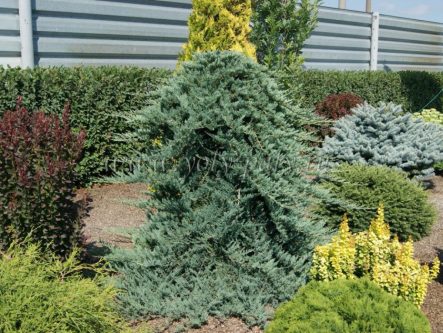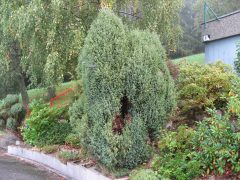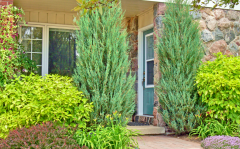Juniper Blue Arrow, which is translated from English as “blue arrow”, is one of the most popular ornamental species of conifers. The shrub bears such a name because of the green-blue color of the needles and the peaked top. The evergreen plant is resistant to frost and unpretentious to the soil, which gives it a great advantage to be a priority among landscape designers when decorating terraces and outdoor areas.
Material Content:
Juniper rocky Blue Arrow: description of the species
Juniper rocky “Blue Arrow” - an evergreen coniferous plant that preserves the green-blue color of the needles for almost its entire life. Rigid, vertical shoots at the base of the shrub form such a bizarre plant shape that does not change under the weight of years or under the influence of aggressive external factors, including weather. The shrub of the Blue Arrow variety grows by 14-16 cm annually.
The average growth indicators are as follows: at the time of its decade, the plant reaches 2-2.5 meters in length with a crown diameter of 65-75 cm. The maximum height of conifers extremely rarely exceeds 5 m. Juniper needles are very soft, scaly and sometimes almost blue at the base. Fruits - pine cones, are also often dark blue.
The peculiarity of the Blue Arrow variety that distinguishes it from many other species is that the lower branches of the tree live very long and begin to die out only after 10-12 years, keeping the crown so fluffy and voluminous.
The nuances of growing
Planting a juniper is simple to indecent, however, you still need to know some points.
First of all, you should remember that the “Blue Arrow” better survives and grows faster on illuminated and sheltered from the wind surfaces.
A very important nuance: in the first year of its growth, juniper is very susceptible to scorching sunlight.
As for the rules of planting, everything is simple, and they are no different from the generally accepted rules for growing any other varieties of conifers:
- Blue Arrow root system should be taken with a lump of land;
- the hole for planting the plant needs to be leveled and expanded so that in addition to the root system with a lump of earth there is free space:
- a layer of drainage material must be laid on the bottom of the well. For these purposes, you need to use only high-quality drainage;
it is recommended to fill the remaining free space with a substrate from the soil and a special mixture for coniferous plant varieties, consisting of the following components:
- peat 45-55%;
- sheet land 20-30%;
- sand 20-30%.
Advice! In order to cope with the increased acidity of the soil, which will necessarily appear in the first month after planting, it is recommended to add a little lime to the hole. You will notice that the seedling will take root much faster.
The next step is to mulch the soil in order to protect it from dehydration. In addition, high-quality mulching work has a positive effect on the aesthetic side of a garden plant.
Juniper planting in open ground
Landing in open ground can be made at different times of the year, and this will depend on the type of root system:
- Shrubs with an open root system in open ground are best planted from mid-spring or early fall.
- Junipers with a closed root system can be planted from any period from mid-spring to early autumn.
For planting, it is recommended to choose a lit place with loamy or sandy soil. The size of the hole for planting should match the size of the root system. The distance between two neighboring plants should be at least 0.5 meters if you intend to grow hedges.
Next, proceed as follows:
- Carefully remove the plant from the container in which it grew.
- Without damaging the roots, transfer the plant to a pre-prepared hole.
- Sprinkle seedlings with earth.
- Pour plenty of cold water.
- Mulch work.
Plant care
Caring for juniper will not cause you any trouble. But it is important to know that excessively dry air is detrimental to both young and adult trees. You will greatly please your plant if you install in the vicinity of the hedge a design of automatic watering, but not drip (since it is more suitable for low-growing plants), but with a sprinkler.
Here are some more tips:
- fertilize no more than once a year, and strictly in the middle of spring;
- if possible, loosen the topsoil periodically;
- water the young plant as often as possible. An older tree is enough to irrigate with water once every few days;
- when preparing a conifer for winter, cover its trunk with peat 7-9 cm.
Juniper Blue Arrow Reproduction
Juniper Virginia is propagated using cuttings or interchangeably. We recommend that you opt for cuttings. To do this, carefully cut the shoots from the plant and immediately place them in the soil, previously loosened.
Cut the shoots in the spring, so that they survive the winter in comfortable conditions and get stronger. Again sprouting shoots should be carefully watered.
Diseases, pests and methods of dealing with them
Rust is a disease that most often affects conifers, especially if hedges are grown from them. If you notice traces of rust on your tree, they should be immediately cut and treated with healthy, trimmed Phytocide branches. And to protect your coniferous plant from the appearance of rust, plant it away from fruit plants.
As for pests, for Blue Arrow the most dangerous are the mining moth and aphid. You can get rid of the mining moth with the help of the Fitoferm sprayer, and from the aphids with the Decis solution.
Please note that the above products are very toxic. Do not forget about safety measures and do not spray them with the plant more often than 1 time in several weeks.
Juniper Blue Arrow for many decades will delight you with its beauty, create a shadow with hedges and protect terraces from many large pests. At the same time, the tree is unpretentious in leaving, will not create problems for you during planting and transplantation. An evergreen plant will bring comfort and harmony to your garden.



